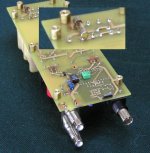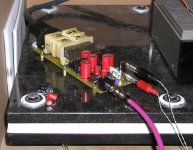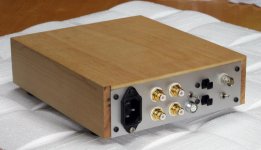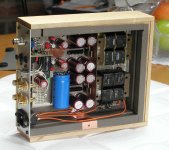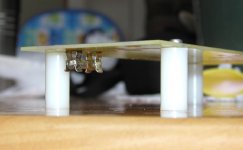There are few reasons I opted for soldered fuse:
While using 3 x 2 tubing, there is not enough space for fuse socket underneath.
From the standpoint of reliability, soldered connection is always better than tiny clamps of a fuse holder.
While the fuse I'm using in a picture, is not particularly suited for direct soldering, it still worked well for the last year I've been using it like that in another circuit. Digi Key has few pages of fuses that are made specificaly for direct soldering to the board.
And lastly, a properly designed device, shouldn't require fuse change in its lifetime, so why would you need a socket for?
While using 3 x 2 tubing, there is not enough space for fuse socket underneath.
From the standpoint of reliability, soldered connection is always better than tiny clamps of a fuse holder.
While the fuse I'm using in a picture, is not particularly suited for direct soldering, it still worked well for the last year I've been using it like that in another circuit. Digi Key has few pages of fuses that are made specificaly for direct soldering to the board.
And lastly, a properly designed device, shouldn't require fuse change in its lifetime, so why would you need a socket for?
Ok, I found the fuse but isn't many fuses soldered inside? Do the manage soldering without any problems?

I see also (correct me if I'm wrong) that your creepage distances are way too narrow, at least for 230 volt countries.
You must have 8 mm between any mains parts to any touchable metal part and in your case it will be your whole stereo.

I see also (correct me if I'm wrong) that your creepage distances are way too narrow, at least for 230 volt countries.
You must have 8 mm between any mains parts to any touchable metal part and in your case it will be your whole stereo.

peranders said:Ok, I found the fuse but isn't many fuses soldered inside? Do the manage soldering without any problems?
I see also (correct me if I'm wrong) that your creepage distances are way too narrow, at least for 230 volt countries.
You must have 8 mm between any mains parts to any touchable metal part and in your case it will be your whole stereo.
There may not be many fuses soldered inside, but this one is. This was an intentional choice. There is a lot of talk about mains connection quality, higher grade receptacles and all those "special" power cords. I simply didn't want to compromize the AC interface by choosing "convenience" over quality. The fuse attachment pads are oversized, so basically any type of fuse can be used here and I still have to experiment what works best. I'm also of opinion that the type of fuse will affect the sound, so the choice is not merely picking sub-mimiature type from D-K catalog. The practicality was never the intention of this product, the best example is the way some caps are mounted.
As to the creepage distance, it is only dictated by the standoffs height. In case of .25" it's about 6mm and with .375 we are well over 8mm. Additionally, the enclosure surface directly under the AC traces and the fuse, can be insulated with special plates.
I just had a quick look through D-K catalog, and this fuse seems like an interesting choice: http://rocky.digikey.com/WebLib/Belfuse/Web Data/MQ.pdf
When I see the solderside of the pcb at the mains side I think it's too tight between the distance screws and one of the connections of the transformer. If you have a metal case _and_ not the protected earth connected which you have to have some countries in Europe, the distance seems to be less than 8 mm, 0.315".
If you always can garantee that the case is grounded it's OK but I think this is a bit unnecessary so if you ever release this board I think you should make the mains side fully professional, as much as you can. If noone can complain not even a testing institute you have really succeeded.
I also think that 48 VA seems bit much for driving a DAC but this is only a point of view and it's your choice.
If you always can garantee that the case is grounded it's OK but I think this is a bit unnecessary so if you ever release this board I think you should make the mains side fully professional, as much as you can. If noone can complain not even a testing institute you have really succeeded.
I also think that 48 VA seems bit much for driving a DAC but this is only a point of view and it's your choice.
peranders said:When I see the solderside of the pcb at the mains side I think it's too tight between the distance screws and one of the connections of the transformer. If you have a metal case _and_ not the protected earth connected which you have to have some countries in Europe, the distance seems to be less than 8 mm, 0.315".
If you always can garantee that the case is grounded it's OK but I think this is a bit unnecessary so if you ever release this board I think you should make the mains side fully professional, as much as you can. If noone can complain not even a testing institute you have really succeeded.
I also think that 48 VA seems bit much for driving a DAC but this is only a point of view and it's your choice.
With regards to wattage of transformer, it's only your POV, however I'm quite surprised that in this case you are not inclined into "extremes" as you usually are.
I cannot gurantee that the case will be grounded. There is attacment to mainds earth, but mains not always are grounded. One could attach RCAs directly to chassis, but I don't think it's agood idea.
With regards to your first paragraph, the hole distance is exactly 6mm from transformer pin. But why not use non metal screw (and standoof) in this particular spot?
Here's the way the DAC assembly from post 125 has been used.
Attachments
UrSv said:
I'm assuming nothing but simply looking at the board. And Per-Anders is right. I'm sorry to see that you are completely missing the point, again, but perhaps that is due to my being unclear.
I am not missing a point. There are different ways to implement this board, and you again assuming that metal fasteners will be used, or even those particular mounting holes.
For a sake of clarity, and better understnding of my choices and options I created here, none of the both holes close to transformer primary have to be used for mounting (when aluminum tubing is used). As you can see, an AC receptacle is mounted directly to the board. This receptacle, attached to the back plate of metal enclosure is enough to support rear end of the board, with no need of using standoofs close to transformer. This again, complies with 8mm creepage distance.
Constant pointing out, on your part, that I don't understand Peranders issues is really insulting.
I would be pretty disappointed if this is not offered as a kit because of a fuse  .
.
I really want to build one of these dacs, it was going to be my first non oversampling dac.
BTW, I solder fuses in my DIY projects. I normally use ceramic fuses, as the standard glass ones don't like to be soldered, but the ceramics work fine after soldering.
Randy
I really want to build one of these dacs, it was going to be my first non oversampling dac.
BTW, I solder fuses in my DIY projects. I normally use ceramic fuses, as the standard glass ones don't like to be soldered, but the ceramics work fine after soldering.
Randy
With regards to bateries, I tested the DAC with both options, and there is really not much advantage to battery power, if any. There are certain advantages to both, and depending on personal taste and preferences (and of course mains quality), both can be equally well enjoyed. I'm not using batteries presently.
UrSv said:
The American market has safety rules as well I presume.
But because of different voltage, those rules are slightly different also.
Again, I really recommend wooden enclosure, with maybe only metal plate on top, which can effectively become a bottom. I did some testing before and that type of enclosure sounded the best.
Attachments
Peter Daniel said:
But because of different voltage, those rules are slightly different also.
Yes, so in this case do the regulations state 4.8 mm or 6 mm?
UrSv said:
Yes, so in this case do the regulations state 4.8 mm or 6 mm?
I made it 10mm (directly on board), just in case the regulations might change in a future. The rest of the clearance depends only on mounting options.
- Status
- This old topic is closed. If you want to reopen this topic, contact a moderator using the "Report Post" button.
- Home
- Amplifiers
- Power Supplies
- Products certifications, safety requirements (and creepage distance)
